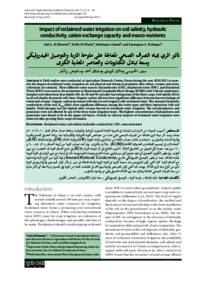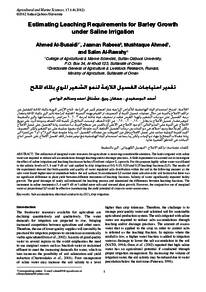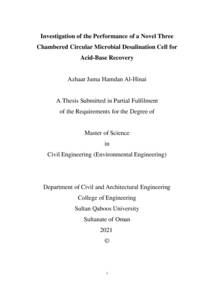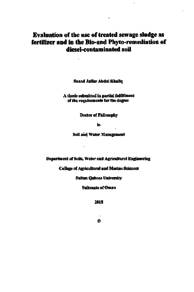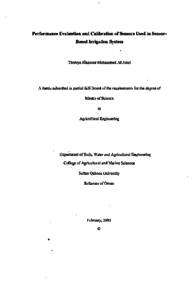Document
Impact of reclaimed water irrigation on soil salinity, hydraulic conductivity, cation exchange capacity and macro-nutrients.
Contributors
Publisher
جامعة السلطان قابوس. كلية العلوم الزراعية والبحرية
Gregorian
2016
Language
English
Subject
English abstract
Field studies were conducted at Agriculture Research Center, Oman during the year 2010/2011 to monitor the impact of reclaimed water irrigation on soil physical and chemical properties after wheat, cowpea and maize cultivation (in rotation). Three different water sources (Groundwater (GW), desalinized water (DW), and Reclaimed Water (RW)) were used as the treatments in Randomized Completely Block Design (RCBD) with 3 blocks (replicates). Samples were taken from four depths (30, 45, 60 and 90 cm) after harvesting time of the three crops. Soil salinity (ECe) in all soil depths decreased with time. Organic carbon did not show significant difference between harvest timings of wheat and cowpea. Organic carbon increased with time in soil irrigated with reclaimed water. The saturated hydraulic conductivity of the soil, Ksat didn't show significant difference among the water types and their interaction with soil depths. Total nitrogen was the highest after cowpea harvest in reclaimed water irrigation. The soil phosphorus and potassium were not affected by any of the three water irrigation types. The highest concentrations of phosphorus and potassium were found to be in the upper soil layers. Overall, no adverse impacts of reclaimed water irrigation were observed after growing three crops of rotation.
Member of
ISSN
2410-1079
Resource URL
Citation
Al-Khamisi, S. A., Al-Wardy, M., Ahmed, M., & Prathapar, S. A. (2016). Impact of reclaimed water irrigation on soil salinity, hydraulic conductivity, cation exchange capacity and macro-nutrients. Agricultural and Marian Sciences Journal, 21 (1), 8-18.
Arabic abstract
أجريت مجموعة من الدراسات الميدانية في المديرية العامة للبحوث الزراعية والحيوانية بسلطنة عمان خال العام 2010/2011م بهدف رصد أثر مياه الري المعالجة من الصرف الصحي على عدد من خصائص التربة الفيزيائية والكيميائية بعد زراعة محاصيل القمح واللوبيا والذرة الشامية (بالتناوب). استخدمت ثلاث مصادر مختلفة من مياه الري (المياه الجوفية (GW) والمياه المحلاة (DW) والمياه المعالجة (RW)) كمعاملات في تصميم القطاعات العشوائية الكاملة (RCBD) بثلاث مكررات. وتم أخذ عينات التربة من أربعة أعماق (30، 45، 60، 90 سم) بعد حصاد كل محصول من المحاصيل الثلاثة. أشارت النتائج إلى أن ملوحة التربة (ECe) في جميع أعماق التربة قد انخفضت مع مرور الوقت. ولم يظهر الكربون العضوي أي فرق معنوي كبير بين توقيتي حصاد القمح وحصاد اللوبيا ووجد بأنه في ازدياد مع مرور الوقت في التربة المروية بالمياه المعالجة. فيما لم يظهر التوصيل الهيدروليكي المشبع (Saturated Hydraulic Conductivity) فرقا كبيرا بين أنواع المياه وتداخلها مع أعماق التربة. كان أعلى تركيز للنيتروجين بعد حصاد اللوبيا في التربة المروية بالمياه المعالجة في حين لم يتأثر تركيز الفوسفور والبوتاسيوم في التربة بأي من أنواع مياه الري الثلاثة. ووجد بأن أعلى تركيز للفوسفور والبوتاسيوم كان في الطبقات العليا من التربة وفي العموم لم يلاحظ أي آثار ضارة من مياه الصرف الصحي المعالجة وذلك بعد ري الثلاثة محاصيل والي تم زراعتها بالتناوب.
Category
Journal articles

